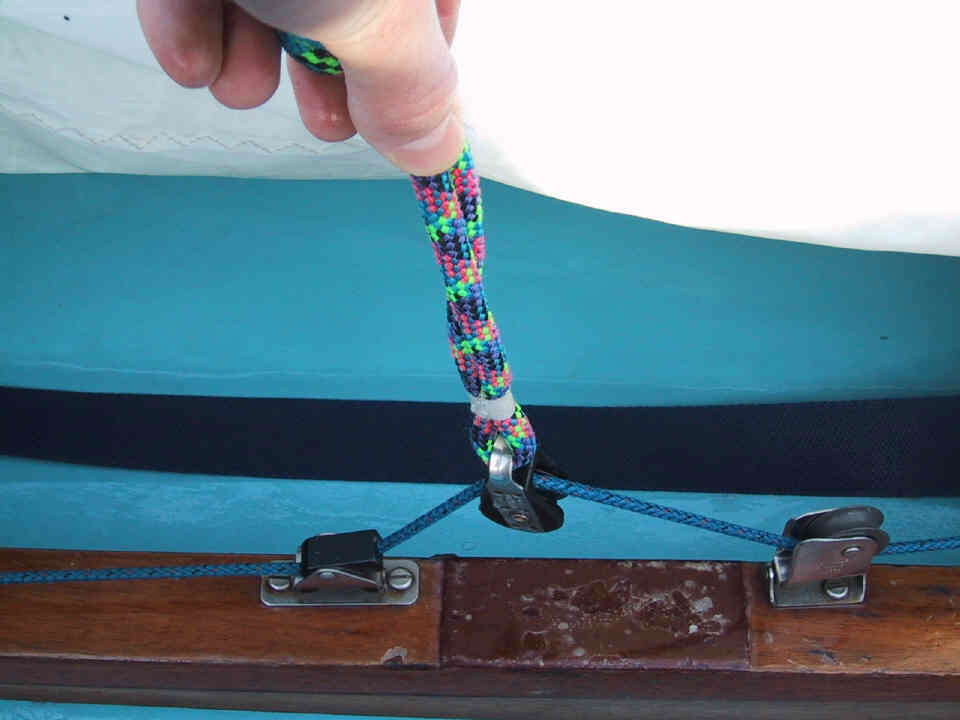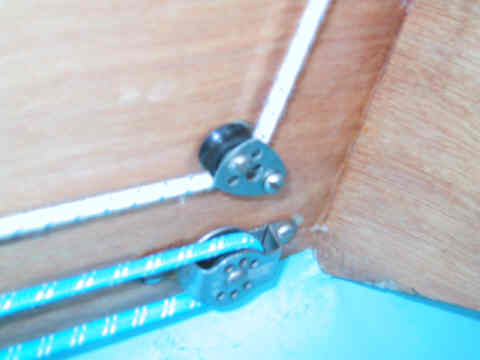 |
 |
|
Now we'll follow the blue spinnaker halyard on its journey round the boat. This bit of rope is responsible for ensuring that the spinnaker can be hoisted
easily, stays up, and comes back down again with minimum of fuss. Ideally it should be a soft pliable rope which travels round pulleys easily. Specialist Fireball chandlers such as P&B and Speed
Sails can sell you this, and will even know how long it needs to be. Don't use any old rope, or even any new rope. Having the right stuff makes a big difference.
|
 |
 |
|
The halyard has turned red in this shot, as this mast is attached to a different boat. It goes into the topmost pulley on the front of the mast, just above the
forestay. It then goes down the inside of the mast to...
|
 |
 |
|
====>> >>
|
|
|
 |
 |
|
the bottom of the mast, where it magically turns back into a white rope with black flecks and emerges through a slot in the port side of the mast. This slot
could have done with being a bit longer - say 1 to 1.5 inches. Then it goes through a pulley screwed into the boat below the mast foot, and whizzes along the centreboard case...
|
 |
 |
|
Here the halyard has returned to being blue, and continues along the spine of the boat. You can see that the halyard has come along the port side of the
centreboard case by the angle at which it emerges into the right hand side of the picture. The first thing it encounters is a flip-block pulley which swivels to work at any angle (P&B code HA4978).
The next shot shows how this operates, although a conventional surface mounting bullseye with a metal ferrule would do just as well. It just has to hold the rope close to the spine of the boat at this
position. Then we have a pulley with a colourful rope handle, followed by a 'Northfix pump cleat' (P&B code NX103).
|
 |
|
|
 |
 |
 |
|
Here we see this arrangement in use. The gifted and talented helmsman stands up in the boat, grabs the colourful rope handle and pulls it above his head. The
pump-cleat locks under the tension this creates, so the helm is in fact hoisting the kite with a 2:1 purchase provided by his pulley. This can in theory hoist the kite to full height with one 'pump'.
When the helm releases the colourful rope handle, the elastic (which we haven't seen yet) takes up the slack through the pump-cleat (which will magically allow this to occur). The spinnaker stays up
because the halyard has been pulled through the cleat on the back of the centreboard case.
|
 |
 |
|
pump-cleat
|
|
|
 |
 |
|
This shows the route that the halyard takes to reach the take-up elastic. The blue elastic can be seen heading towards the front of the boat along the port side
tank, and returning to cross the boat at the transom to go front and back again along the starboard side tank. Basically, this needs to be a long bit of elastic.
|
 |
 |
|
This shot shows the halyard finishing its journey at the elastic take-up arrangement. This boat uses 4:1 from 2 double pulleys. 6:1 from 2 triple pulleys is
also often used.
|
 |
|
|
 |
|
|
Elastic gets to front of port side tank and heads for the back again. See picture above for view of back port corner of cockpit.
|
|
|
 |
 |
|
You will need to get enough of the blue elastic to do the business. It needs to be stretched enough that when the kite is up, the slack halyard is taken up
nicely. However, if you overdo the tension, you'll find that the elastic is always trying to hoist the kite out of the bag for you, which is a pain in the bum and doesn't help the crew when he/she is
retrieving the thing.
The white elastic which you can see in the previous three shots is the take-up elastic for the trapeze hooks.
For further details of the guy, sheet and spinnaker pole arrangements, click here.
|
|
|

